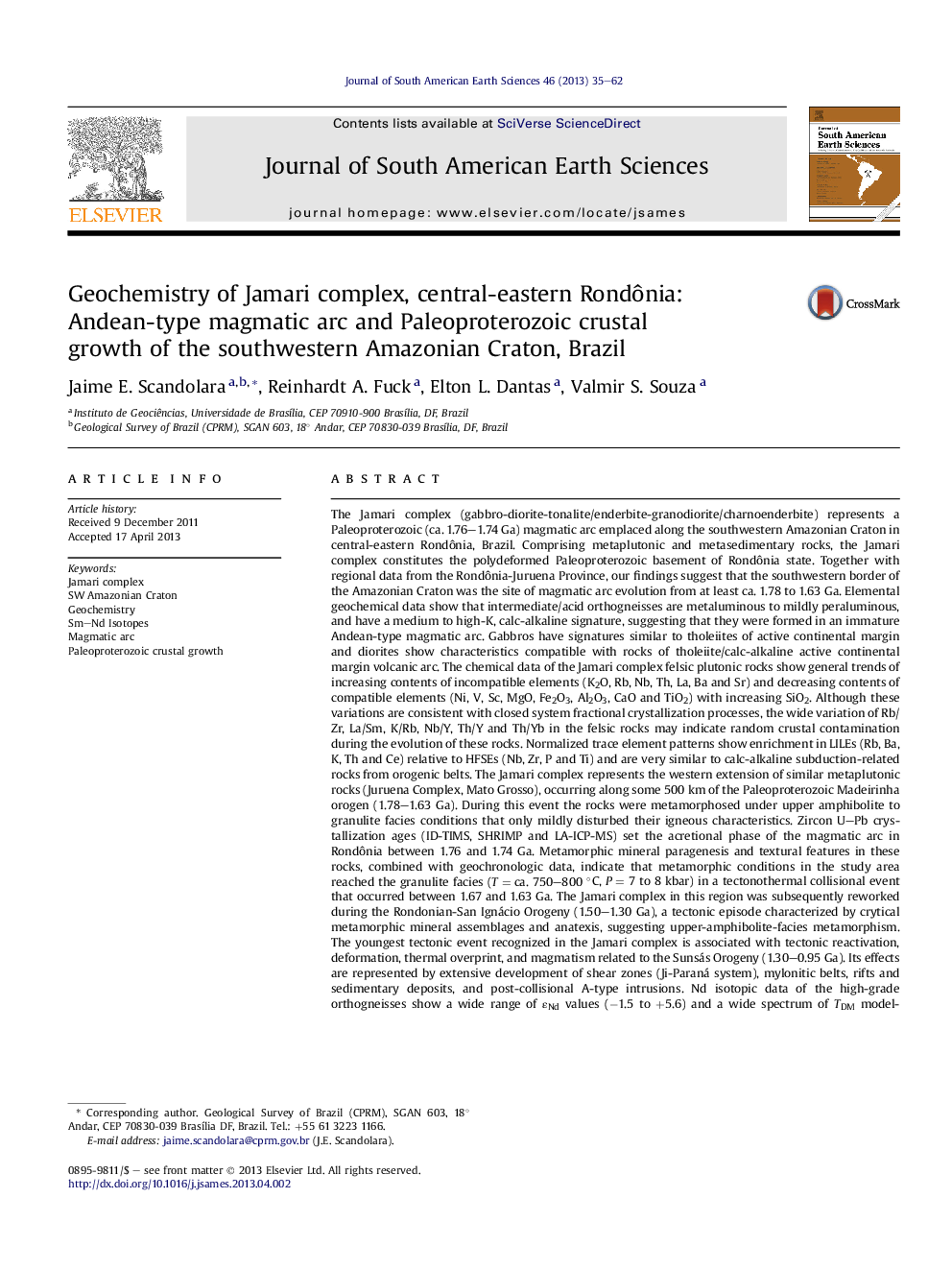| کد مقاله | کد نشریه | سال انتشار | مقاله انگلیسی | نسخه تمام متن |
|---|---|---|---|---|
| 4682422 | 1635163 | 2013 | 28 صفحه PDF | دانلود رایگان |

• Isotopic and elemental geochemical data and signature of the Jamari complex.
• Plutonic rocks and characterization of Andean-type magmatic arc suite nature.
• We discussed their petrogenesis and sources, suggested a geologic scenario and evolution.
The Jamari complex (gabbro-diorite-tonalite/enderbite-granodiorite/charnoenderbite) represents a Paleoproterozoic (ca. 1.76–1.74 Ga) magmatic arc emplaced along the southwestern Amazonian Craton in central-eastern Rondônia, Brazil. Comprising metaplutonic and metasedimentary rocks, the Jamari complex constitutes the polydeformed Paleoproterozoic basement of Rondônia state. Together with regional data from the Rondônia-Juruena Province, our findings suggest that the southwestern border of the Amazonian Craton was the site of magmatic arc evolution from at least ca. 1.78 to 1.63 Ga. Elemental geochemical data show that intermediate/acid orthogneisses are metaluminous to mildly peraluminous, and have a medium to high-K, calc-alkaline signature, suggesting that they were formed in an immature Andean-type magmatic arc. Gabbros have signatures similar to tholeiites of active continental margin and diorites show characteristics compatible with rocks of tholeiite/calc-alkaline active continental margin volcanic arc. The chemical data of the Jamari complex felsic plutonic rocks show general trends of increasing contents of incompatible elements (K2O, Rb, Nb, Th, La, Ba and Sr) and decreasing contents of compatible elements (Ni, V, Sc, MgO, Fe2O3, Al2O3, CaO and TiO2) with increasing SiO2. Although these variations are consistent with closed system fractional crystallization processes, the wide variation of Rb/Zr, La/Sm, K/Rb, Nb/Y, Th/Y and Th/Yb in the felsic rocks may indicate random crustal contamination during the evolution of these rocks. Normalized trace element patterns show enrichment in LILEs (Rb, Ba, K, Th and Ce) relative to HFSEs (Nb, Zr, P and Ti) and are very similar to calc-alkaline subduction-related rocks from orogenic belts. The Jamari complex represents the western extension of similar metaplutonic rocks (Juruena Complex, Mato Grosso), occurring along some 500 km of the Paleoproterozoic Madeirinha orogen (1.78–1.63 Ga). During this event the rocks were metamorphosed under upper amphibolite to granulite facies conditions that only mildly disturbed their igneous characteristics. Zircon U–Pb crystallization ages (ID-TIMS, SHRIMP and LA-ICP-MS) set the acretional phase of the magmatic arc in Rondônia between 1.76 and 1.74 Ga. Metamorphic mineral paragenesis and textural features in these rocks, combined with geochronologic data, indicate that metamorphic conditions in the study area reached the granulite facies (T = ca. 750–800 °C, P = 7 to 8 kbar) in a tectonothermal collisional event that occurred between 1.67 and 1.63 Ga. The Jamari complex in this region was subsequently reworked during the Rondonian-San Ignácio Orogeny (1.50–1.30 Ga), a tectonic episode characterized by crytical metamorphic mineral assemblages and anatexis, suggesting upper-amphibolite-facies metamorphism. The youngest tectonic event recognized in the Jamari complex is associated with tectonic reactivation, deformation, thermal overprint, and magmatism related to the Sunsás Orogeny (1.30–0.95 Ga). Its effects are represented by extensive development of shear zones (Ji-Paraná system), mylonitic belts, rifts and sedimentary deposits, and post-collisional A-type intrusions. Nd isotopic data of the high-grade orthogneisses show a wide range of εNd values (−1.5 to +5.6) and a wide spectrum of TDM model-ages, from 1.79 to 2.2 Ga. These values demonstrate that the crustal generation processes involved juvenile mantle sources and variable proportions of older recycled crust.
Journal: Journal of South American Earth Sciences - Volume 46, October 2013, Pages 35–62